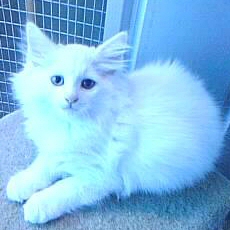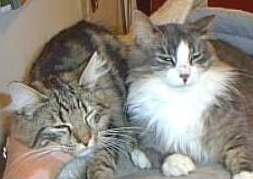| Article |  |
|
If you are considering adopting a Norwegian Forest Cat, make sure you have room in your home - and heart - for a second one! This is the experience I have had since I started breeding in 1998 from one of the very first NFC males to be born in Australia. Almost everyone who has adopted one from me has come back for a second and even a third, as they are such good company for their owners and each other. Inquisitive, intelligent to the point of outsmarting their owners, confident and highly affectionate, these cats make wonderful pets. If you are a breeder, I can guarantee your Norwegian will become one of your favourite cats and you will want to keep one as a special pet, as they are so engaging and entertaining.
Their coats are long and water-resistant, but they moult once a year in mid-Spring when they will need some extra grooming help. They love being brushed or combed, and roll over in ecstasy, showing their tummies and purring loudly to get your attention. Because they are naturally excellent climbers, being one of the few breeds that will come down a tree headfirst or can scale an almost vertical rock face, they have large claws which need trimming on a regular basis so that they don’t hook your clothes when you cuddle them. Trim the nails gently and carefully, speaking to your “Wegie” soothingly, and he will always be co-operative when you need to perform this regular duty of care. A good scratching post with several different levels, tunnels and strong ‘trunk’ will be well used and give your pet(s) lots of fun and exercise, and keep those claws in trim.
With triangular-shaped heads, the Norwegian peers nobly down its long, straight nose at you, commenting on everything you do with intelligent observation. Its large paws often knead the air to accentuate what it is trying to say! Strong, robust and generally enjoying excellent health, the Norwegian’s lifespan can reach 20 years or more, if well looked after. Which is a long time to enjoy the company of the best friend you’ll ever have! Loraine Smith |
|
|
|
 Life
with a Norwegian
Life
with a Norwegian They are the clowns of
the cat world, as playful when adult as they are as kittens, and watching
a 6-year old heavyweight male nimbly chasing the red dot of a laser light
will have you in tears of laughter! There is not a door that a Norwegian
(also known as NFC, NFO, Skogkatt, "Wegie" or
"Norgie") cannot somehow get the other side of, so be very
careful to keep exits well shut as they love to explore. If your pet
escapes outdoors, be prepared to spend a couple of hours trying to catch
him again as they are very cunning and extremely fast. Train one to walk
ahead of you on a leash from an early age, and enjoy their company as you
stroll around the block - exercise for you and him, and he will probably
be more obedient and less trouble than most dogs.
They are the clowns of
the cat world, as playful when adult as they are as kittens, and watching
a 6-year old heavyweight male nimbly chasing the red dot of a laser light
will have you in tears of laughter! There is not a door that a Norwegian
(also known as NFC, NFO, Skogkatt, "Wegie" or
"Norgie") cannot somehow get the other side of, so be very
careful to keep exits well shut as they love to explore. If your pet
escapes outdoors, be prepared to spend a couple of hours trying to catch
him again as they are very cunning and extremely fast. Train one to walk
ahead of you on a leash from an early age, and enjoy their company as you
stroll around the block - exercise for you and him, and he will probably
be more obedient and less trouble than most dogs. If you can make room
for two, you will have a devoted couple who play romp with each other
during the day, and cuddle each other in the same bed at night, but also
make time to be with you, to keep you amused and to welcome you home at
night.
If you can make room
for two, you will have a devoted couple who play romp with each other
during the day, and cuddle each other in the same bed at night, but also
make time to be with you, to keep you amused and to welcome you home at
night.